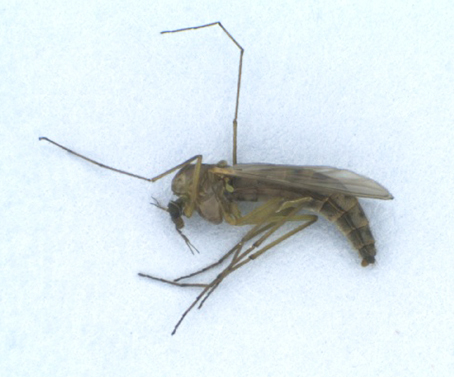| Fe
| Ti
| Ta1
| Ta2
| Ta3
| Ta4
| Ta5
| LR
| F/T
| Ta4/Ti
|
PI
| 58
| 54
| 70
| 36
| 26
| 24
| 10
| 1.30
| 1.07
| 0.44
|
PII
| 52
| 54
| 32
| 20
| 16
| 10
| 6
| 0.47
| 0.96
|
|
PIII
| 84
| 76
| 36
| 28
| 22
| 14
| 8
| 0.65
| 1.10
|
|
Pupa: No information.
Fourth instar larva: A bathophilus-type larva. Length about 13-15 mm. Ventral tubules from 0.6-1.5 mm., anterior pair usually longer. Anal tubules: dorsal pair about three to four times as long as wide, ventral pair often longer with a constriction, and about three times as long as wide. Head capsule with pale frontoclypeus, slightly dark or dark on posterior region of gula.
Mentum with 4th lateral reduced to about level of 5th laterals (type II); centre trifid tooth with distinct c2 teeth (i.e. Type II or worn Type III).
Ventromental plates separated by about 0.29-0.37 of mentum width, with about 43-50 striae. Pecten epipharyngis with about 10-20 rather uneven teeth.
Basal segment of antenna about 2.7-4.2 times as long as wide; 4th segment relatively short, generally less than 30% longer than segment 3, which is longer than segment 5; segment proportions (micron) 128 : 32 : 10 : 13: 7.
Premandible with inner tooth about 2.2-2.7 times as wide as outer tooth, outer tooth usually shorter.
Mandible with 3rd inner tooth darkened and but only slight separation (i.e. type IIC); about 17-23 furrows on outer surface near the base.
Cytology: 4 polytene chromosomes with the pseudothummi arm combination (AE, BF, CD, G).
Arm G with a subterminal nucleolus and nearby Balbini ring I(BR). No nucleolus in long chromosomes.
Arm B with unique sequence, with a large puff or BR near the centromere. This may be group 7, but the possibility cannot be excluded that this is homologous to the BR developed in a similar position in species such as the Holarctic C. plumosus, which is not equivalent to band group 7.
Polymorphism in arm C.
spiA1: 1a-e, 11 - 10, 2c - 1f, 3e - 2d, 8 - 9, 3f-i, 12c-a, 4 - 7, 13 - 19 i.e. as A4 oppositus and A1 of novae-zelandiae, analis, forsythi
spiB1: Bulb (group 7) close to centromere, dark bands further to distal end.
spiC1: as nzlC1, etc.
spiC2: inversion of about the extent of nzlC3
spiD1: 1 - 2, 16 - 10d, 3a-d, 9 - 3e, 10a-c, 17 - 24 i.e. as nzlD1
spiE1: 1 - 3e, 11 - 10c, 3f - 10b, 12 - 13 simple inversion from nzlE1
spiF1: 1 - 2a, 10 - 2c, 15c - 11a, 2b, 15d - 23, i.e. as oppositus F3, and F1 of novae-zelandiae, analis, forsythi, but with no nucleolus
spiG1: Virtually terminal nucleolus with nearby BR.
Molecular
Mt COI - a number of sequences are in the BOLD database, where they are placed in the BIN AAL7009.
Localities:
North Island:
Cambridge, South Auckland (-37.89°S, 175.44°E) (Sofia Ibarrarán) 29-viii-2007.
Lake Ngahewa, South Auckland (-38.31°S, 176.37°E) (Sofia Ibarrarán) 29-vii-2007.
Lake Rotoiti, about 16 Km north east of Rotorua, South Auckland (-37.28°S, 174.67°E) (NZ.19.1) (Jon Martin & D.J. Forsyth) 7-xii-1973.
Waikato (-37.802°S, 175.334°E) (Ian Hogg) 29-iv-2013.
Waikato, South Auckland (-37.809oS, 175.137oE) (BOLD NZIN5065-12) (Grant Broomfield) 26-ix-2012.
Initially included with C. novaezelandiae, but shows consistent differences in the lighter larval dorsal head colour, some unique chromosome banding patterns and the lack of a nucleolus in arm F.
The existence of this species was first indicated by the barcoding analyses of Sofia Ibarrarán, and the BIN analyses of the BOLD database place it in a separate BIN.
See also C. species NZ10, and C. species NZ12.[ Return to Key| Go to References ]